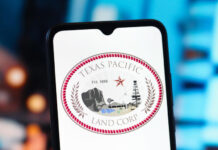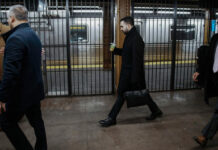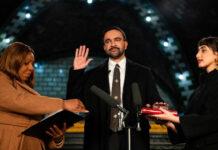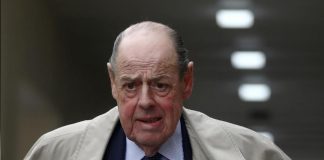JANUARY 17, 2021
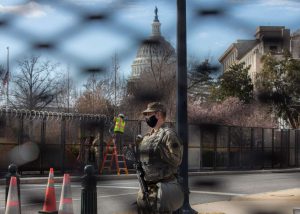
Razor wire continues to be installed along fencing around the Capitol Sunday. (Photo by Evelyn Hockstein/For The Washington Post)
The troops were in formation. The residents were told to stay home. The heart of Washington was a fortress of fences, concrete barriers and security checkpoints. But on Sunday, the planned and promoted “armed march” on the nation’s capital never materialized.
There were no gathered crowds, large or small, and authorities reported just one arrest of an armed man carrying a handgun and ammunition near barricades surrounding the Capitol building just after midnight.
The quiet Sunday brought little relief to a city on edge from an attack on the Capitol. Each day leading up to the inauguration of President-elect Joe Biden comes with fear of additional violence and ever more security.
“It’s as if we are all being held hostage to people who want to bring a lot of chaos to America,” said Charlyce Wilson, a 62-year-old Washingtonian who has been to nearly every inauguration since she was 11. On Sunday, she was boarding a train at Union Station that would take her to Florida for the week, where she knew she’d feel safer as a Black woman.
Since Jan. 6, when a pro-Trump mob staged a deadly riot as the House and Senate certified Biden’s election, Washington has been a city split in two. Its center, once pulsing with visitors for inaugurations past, has become an armed encampment, surrounded by the 10,000 National Guardsmen already in the District. Outside of those barriers are the hundreds of thousands of residents who have weathered a pandemic, a summer of protests and now, the consequences of law enforcement officials’ efforts to ensure there isn’t another national security failure.
Those officials had been bracing for a chaotic Sunday since right-wing forums began urging instigators to bring their firearms to every state capitol in the country on Jan. 17. Extremist organizations including the Proud Boys, Three Percenters, Oath Keepers and Boogaloo indicated plans to come to the District.
But after the attack on the Capitol, and the pouring in of military personnel in the days that followed, the online chatter turned to warnings that the District was a “trap.” The organizer of a “Million Militia March” and the leader of the Proud Boys urged followers to stay away. President Trump, shortly before being impeached for the second time, released a video statement asking his supporters to remain peaceful.
Federal and local law enforcement across the country vowed to remain vigilant, understanding that all too often, it only takes one dangerous person for violence to begin. Their shows of force seem to have convinced protesters to stay away from most state capitals as of Sunday afternoon. Small crowds assembled in Columbus, Ohio; Lansing, Mich.; Salem, Ore.; and Austin, where a group of men with rifles swung across their shoulders told reporters they were there to “make sure things stay civil.”
Sunday is quiet at statehouses braced for violent protests
In Annapolis, where local police, state troopers and National Guardsmen were protecting the Maryland State House, the most rambunctious activity came from local dogs that wanted to greet the bomb-sniffing canines patrolling the area. In Richmond, police erected barricades in hopes of preparing for Monday, when a pro-gun rally is expected to bring a caravan of buses, cars and trucks to the Virginia capital.

Armed groups cross the street as they hold a rally in front of a closed Texas State Capitol in Austin, Texas, on Sunday. (Photo by Matthew Busch / AFP via Getty Images)
Washingtonians are accustomed to seeing heightened security around inaugurations and other major events. To live in the nation’s capital is to grow accustomed to its inconveniences: motorcades holding up traffic, military helicopters passing overhead, tourists standing on the wrong side of the escalator. But no event in recent memory has transformed the city to this extent, with monuments inaccessible, bridges shut down, Metro stations shuttered and some residents required to show ID just to get home.
“I haven’t seen it like this since 9/11… At least then you could navigate the streets,” said Rick Dibella, a 67-year-old real estate developer who had to ditch his Uber and walk when his driver reached a barrier north of the Capitol.
Every military vehicle and checkpoint he saw was a reminder of the violent mob from the week before. Dibella, who described himself as a Republican disturbed by the direction of his political party, had little hope that the worst had passed. “I don’t think this time these young men are going to stand down,” he said.
His prediction was echoed across the city, as Washingtonians spent their post-insurrection, pre-inauguration days answering texts from concerned relatives and stocking up at the grocery store, where even the cashiers remind them to “stay safe.”
How battered D.C. police made a stand against the Capitol mob
The shadow hanging over the city stretched far beyond where the military presence stopped. East of the river, residents along Martin Luther King Jr. Avenue — soon to be cut off from downtown by the closure of the 11th Street Bridge — were mourning the celebratory atmosphere they had hoped would accompany the inauguration of Biden, who 92 percent of D.C. voters supported, and Kamala D. Harris, the first Black, first Asian and first female vice president in the nation’s history.
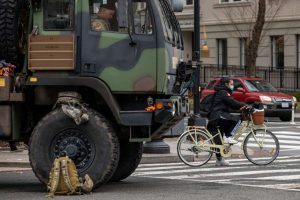
A woman bikes past military forces in downtown Washington Sunday. (Amanda Andrade-Rhoades/For The Washington Post)
“No one can focus on it because of this smokescreen, this specter of violence,” said the Rev. Lawrence Watson Sr., fresh from Sunday service and lugging his bass guitar.
The gloom seeped into the cab of Dennis Abigoe, 56, who sat waiting for nonexistent travelers at an empty Union Station.
“This is the country that the whole world is looking at,” said Abigoe, an immigrant from Ghana. “To see the whole place messed up like that, it’s a disgrace.”
Residents attempting to go about their routines found themselves coming face-to- face with edges of the militarized zone intended to keep them safe. Robyn Hinson-Jones, 69, was walking her mini Australian Shepherd down East Capitol Street early Sunday afternoon when a federal officer began shouting, “This street is closed.”
Tell The Post: What are your plans for Inauguration Day?

Police extend the security perimeter around the Capitol Sunday by pushing people back on East Capitol Street to 3rd Street NE. (Photo by Evelyn Hockstein/For The Washington Post)
“I have to say, I feel protected, whatever that means,” Hinson-Jones said. “Although the irony is not lost of me. These are the same officers we were demonstrating against a few months ago and saying Black Lives Matter. We were running away from them last month and this month we’re going toward them and saying, ‘Thank you, thank you.’ ”
All along the perimeter to the off-limits areas, the multitude of security forces were on high alert for anyone with weapons. Shortly after midnight Sunday, D.C. police arrested a 22-year-old Virginia man who was walking on the 200 block of Massachusetts Avenue NE with a Glock 22 firearm “clearly visible” in a holster. Officers discovered Guy Berry of Gordonsville, Va., was also carrying three high-capacity magazines and 37 rounds of ammunition.
That event followed two arrests by the U.S. Capitol Police in recent days. Saturday morning, a woman who has not been identified was taken into custody after claiming to be a law enforcement officer. She was taken in for a psychiatric evaluation. On Friday night, Wesley Allen Beeler, 31, of Front Royal, Va., was arrested at a checkpoint after police discovered a gun and ammunition in his car. He was charged and released on personal recognizance Saturday, and claims he was on his way to a security job when he got lost in the city.
People were allowed to pass through some barricades, entering “green zones” that were closed to vehicle traffic but open to pedestrians. That was how the only protesters to be found in Washington Sunday — fewer than two dozen people — made their way to Black Lives Matter Plaza, located in a restricted-entry zone.
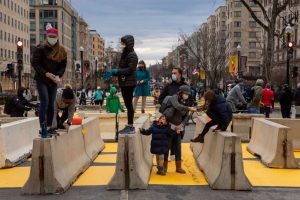
Onlookers climb onto barricades to get a better view of Black Lives Matter Plaza in D.C. on Sunday. (Amanda Andrade-Rhoades/For The Washington Post)
A fence blocked them from going past the “R” still painted in yellow on the pavement, but much like every day since the street took on its name in June, the atmosphere was festive. Reggae boomed from loudspeakers. A few children danced in the street. Some people grabbed sidewalk chalk and wrote in huge letters “domestic terrorists not welcome.”
Julie Dana walked there after passing armed National Guardsmen on H Street.
“I was looking to see any happiness, any place where anybody was celebrating that this was an inauguration,” she said. “Where can we celebrate and usher [Biden and Harris] in with a little bit of joy?”
Joy: To find it anywhere in the city, residents said they felt like they had to get out of their houses, reclaim their neighborhoods, put one foot in front of the other. Which is how Margo Brasil, a prekindergarten teacher, had made her way to 3rd and Pennsylvania Avenue SE, about as close to the Capitol as anyone can get.
Her parents, an aunt and friends had called her to beg her to stay inside this week. But on Sunday afternoon, she was outside again, watching a forklift load more concrete barriers into place, blocking her from the Mall that for two decades has felt like her backyard.
“My liberties — everyone’s liberties — are being stepped on,” she said. “Is this the right thing to do? I think it is, because we have to protect our democracy.”
Soldiers on the streets, helicopters in the air and tension all around reminded her of Sept. 11, 2001, too. But something was different. Twenty years ago, the country had come together, she said. Now it was coming apart.
Courtesy/Source: Washington Post


